On the Hill
Ordinations: Priesthood and diaconate
46 earn master’s degrees


Tailor Shop: Sew much history
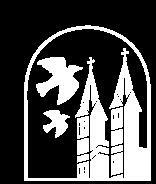



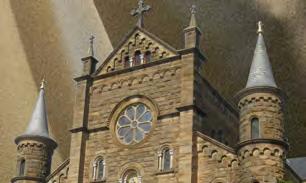
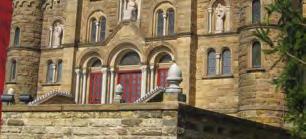
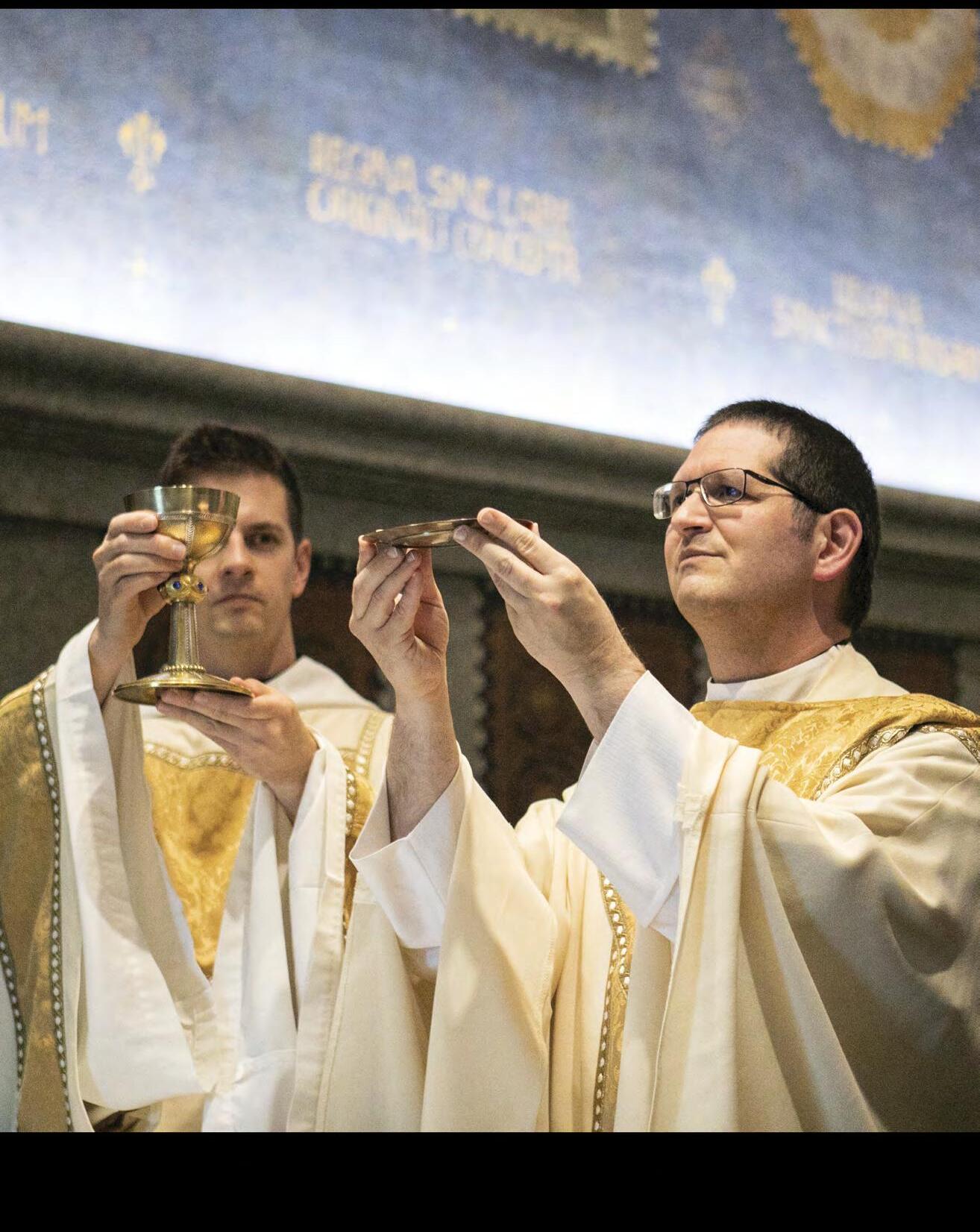










On the Hill is published four times a year by Saint Meinrad Archabbey and Seminary and School of Theology. The newsletter is also available online at:
Editor: Mary Jeanne Schumacher Copywriters: Krista Hall & Tammy Schuetter
Send changes of address and comments to:
The Editor, The Development Office, Saint Meinrad Archabbey and Seminary & School of Theology, 200 Hill Drive, St. Meinrad, IN 47577, (812) 357-6501 • Fax (812) 357-6759, news@saintmeinrad.edu www.saintmeinrad.edu, © 2021 Saint Meinrad Archabbey
Fr. Harry Hagan gave the annual retreat for Conception Abbey and for Assumption Abbey in May.
Br. Michael Reyes premiered a new song commissioned by the Epiphany Catholic Church in Louisville, KY, in early June. He also was one of six featured composers in the virtual concert, “Soundstream-ing Beyond Notes 2021,” hosted by the Asian Composers League.
Archabbot Kurt Stasiak and Fr. Meinrad Brune attended the 60th anniversary of ordination of priesthood of retired Bishop Gerald Gettelfinger of Evansville, IN, on June 3. The Mass was at St. Benedict Cathedral. Fr. Meinrad is an ordination classmate.
Fr. Anthony Vinson celebrated the Baccalaureate Mass for graduates and parents at Saint Xavier High School in

You can find more photos of Saint Meinrad events at http://saint-meinrad.smugmug.com
Louisville, KY, in May 2021, where he has served as school chaplain since 2008.
Fr. Eugene Hensell gave the community retreat for the monks of Marmion Abbey, in Aurora, IL, June 6-10.
Fr. Christian Raab preached a parish mission on the domestic church at Saint Paul Parish, Ithaca, MI, from May 24-27, and preached the Diocese of Little Rock Priest Retreat from June 7-11. He also was a guest on the “All Set for Sunday” podcast on June 2.
Br. Michael Reyes recently gave an online academic lecture on electroacoustic music to the college and conservatory music students and faculty of the Philippines.
Br. Simon Herrmann served as chaplain to the “One Bread, One Cup” college interns during the 2021 college internship
and summer youth conferences. He has been involved in the conferences almost every year since he was a high school participant in 2005.
Br. John Mark Falkenhain co-organized and taught the online “Professional Training Series Mental Health Matters,” a collaborative project between Saint Luke Institute and Saint Meinrad Archabbey. The training series, which ran in March and April, drew 180 participants from all over the world, including England, Norway, Sweden, Australia, Canada, France and the U.S.
Fr. Julian Peters directed the ordination retreat for the permanent deacon candidates in Springfield, IL, June 2-6. He also directed the ordination retreat for the Diocese of Owensboro at Saint Meinrad Archabbey July 18-23. W
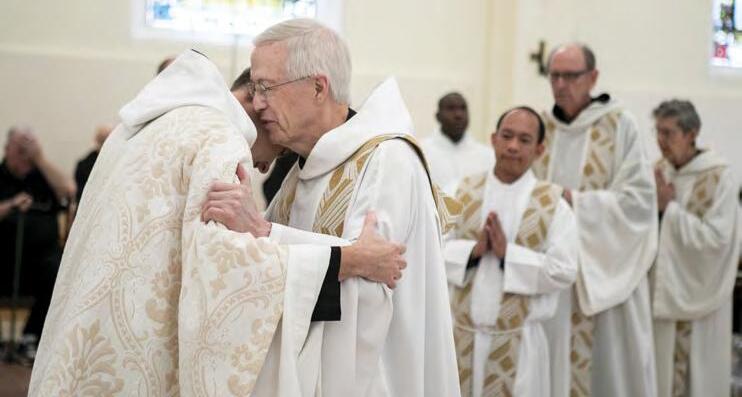
Indianapolis. The ordination was held in Saint Meinrad’s Archabbey Church.
Fr. Simon is a former resident of Findlay, OH, and a graduate of the University of Fr. Simon Herrmann, OSB, a monk of Saint Meinrad Archabbey, was ordained as a Roman Catholic priest on June 27 by the Most Rev. Charles C. Thompson, archbishop of the Archdiocese of
Dayton, where he earned a bachelor’s degree in communication management in 2010. He earned a Master of Arts in Catholic philosophical studies in 2017 and a Master of Divinity in 2021, both from Saint Meinrad Seminary and School of Theology.
He worked as an associate editor for the national office of Beta Theta Pi fraternity from 2010-11 and then at Saint Meinrad Archabbey as the director of alumni relations from 2011-14. He also served as a college intern for three summers in the “One Bread, One Cup” program.
Fr. Simon joined the monastic community in January 2015 and professed his solemn vows in 2019. In August, Fr. Simon will begin an assignment as the director of young adult engagement in the Development Office at Saint Meinrad. W

Br. Angelo Vitale, OSB, a monk of Saint Meinrad Archabbey, died in the monastery infirmary on Sunday, May 2, 2021. He was 80.
Br. Angelo was born in Connellsville, PA, on February 26, 1941, to Anthony J. and Catherine E. (Suwila) Vitale, and he was given the name Pasquale William at his baptism.
He attended high school in Hope, IN, at Bruté Latin School in Indianapolis, and then at St. Mary’s College in St. Mary, KY. In 1958, he entered St. Placid Hall at
Saint Meinrad Archabbey, where he completed high school. During this time, he worked in the Abbey Carpenter Shop.
Invested as a novice on May 10, 1961, he professed his simple vows on May 13, 1962, and his perpetual vows on November 13, 1965. He solemnly affirmed his vows on March 21, 1973.
Br. Angelo’s first monastic assignment was in the bakery. He also rang the tower bells for Mass and Vespers for several years. He enjoyed long tenures as one of the monastic community’s barbers and as a radio operator for the Saint Meinrad Volunteer Fire Department.
Br. Angelo will be remembered most for his 56 years as tailor and shoemaker. He supplied his confreres with habits,
cucullas, albs and stoles, and performed these services for various religious communities throughout the country. He was a student of the Mayer School of Fashion Design of New York City, specializing in pattern making.
Br. Angelo was a member of the National Registry for Orthopedic Shoe Technicians and was recognized for his craftsmanship in the art and skill of shoe modifications and the custom making of shoes as directed by the medical profession.
He was in the 58th year of his monastic profession.
The funeral was celebrated on May 5 in the Archabbey Church, followed by burial in the Archabbey Cemetery. W
September 6 & October 25
Iconography Lecture by Marek Czarnecki, 6:30 p.m., St. Bede Theater
September 10-12
Guest House Retreat: “Spiritual Integration: Fitness, Health and Physical Well-being” by Br. Nathaniel Szidik, OSB
September 17-19
Guest House Retreat: “How to Read the Biblical Prophets” by Fr. Eugene Hensell, OSB
September 24-26
Guest House Retreat: “Contemplative Living” by Fr. Adrian Burke, OSB
September 28-30
Guest House Retreat: “Healing Anger Through Forgiveness” by Br. Zachary Wilberding, OSB
October 1-3
Guest House Retreat: “Unpacking the Vocation of Marriage through Scripture and Married Saints” (Married Couples Retreat) by Josh and Angie Greulich
October 8-10
Guest House Retreat: “The Rule of St. Benedict for Life Today” by Fr. Harry Hagan, OSB
October 15-17
Guest House Retreat: “Being Humble, Being Holy” by Fr. Adrian Burke, OSB
October 18-22
Guest House Retreat: “A Conversation with St. Paul Regarding the Trials of Pastoral Ministry” (Priests Retreat) by Fr. Eugene Hensell, OSB
October 26-28
Guest House Retreat: “Gratitude” by Br. Zachary Wilberding, OSB
October 30
Abbot Martin Marty Guild and Einsiedeln Society Day of Recollection
For more information, contact Mary Jeanne Schumacher at (812) 357-6501 or visit our website www.saintmeinrad.org
Five seminarians received the order of deacon from the Most Rev. Charles Thompson, archbishop of the Archdiocese of Indianapolis, IN, at the Saint Meinrad Archabbey Church on April 10.
The newly ordained deacons are Matthew Perronie and Michael Clawson of the Archdiocese of Indianapolis; Joseph Nam of the Diocese of Busan, Korea; and Br. Nathaniel Szidik, OSB, and Br. Kolbe Wolniakowski, OSB, of Saint Meinrad Archabbey. All are students at Saint Meinrad Seminary and School of Theology.
Others in their class will be or have been ordained deacons in their respective dioceses.
In the Catholic faith, a deacon can preach, baptize, witness marriages, offer Communion to the sick and aged, and perform other ministerial duties. The newly ordained deacons are transitional deacons, meaning they are preparing for ordination to the priesthood. Many Catholic dioceses also have permanent deacons, who carry out the same role, but are not studying for the priesthood. W


Archabbot Kurt Stasiak, OSB, leader of the monastic community at Saint Meinrad Archabbey, announced several appointments recently.
Fr. Bede Cisco, OSB, was named prior of the monastery (second in leadership); Fr. Joseph Cox, OSB, was named subprior; and Fr. Justin DuVall, OSB, was named novice and junior master. They began their new assignments in June.

Fr. Bede succeeds Fr. John McMullen, OSB, who has served as prior since Archabbot Kurt was elected archabbot in June 2016. Fr. Bede has served in various capacities in Saint Meinrad Seminary and School of Theology, most recently as the director of the Spiritual Formation Program. Fr. John also serves as an associate priest at St. Meinrad and St. Boniface parishes.

Fr. Joseph succeeds Fr. Guerric DeBona, OSB, as subprior. Fr. Joseph also oversees technical services and cataloging in the Archabbey Library and is chaplain for the Benedictine
Oblate Community. Fr. Guerric assumed the position of director of the Spiritual Formation Program. He also teaches in the Seminary and School of Theology and is the author of several books.

Fr. Justin, the new novice and junior master, most recently served as the vice-rector of Bishop Simon Bruté College Seminary in Indianapolis, IN. Prior to that, he
served as archabbot of Saint Meinrad from 2004 to 2016. Other assignments have included monastery prior and vice rector of the Seminary and School of Theology.

In another appointment, Fr. Simon Herrmann, OSB, will begin work in August as the director of young adult engagement in the Development Office. As part of his work, he will lead or facilitate on- and off-campus events and retreats for young adults, undertake outreach to young adults and other donors, participate or preside at weddings and baptisms for young adults, and take part in other development events. W
Saint Meinrad Seminary and School of Theology received two grants this spring.
A $75,000 grant from the American Association for the Advancement of Science’s (AAAS) Science for Seminaries project will allow faculty to incorporate science into their theology courses.
Saint Meinrad is one of eight U.S. seminaries awarded a grant in 2021. Saint Meinrad’s project, called “The Gospel of Jesus Christ in Big History,” will use its grant to better integrate science into several courses in the master’s degree curriculum.
Funding will be allocated to faculty for research materials and for conference
participation. In addition, Saint Meinrad plans to host a campus-wide public event in the spring of 2022 that will feature lectures by science and theology speakers, roundtable discussions and workshops.
Science for Seminaries is a project of the AAAS Dialogue on Science, Ethics and Religion (DoSER) program in partnership with the Association of Theological Schools. The goal is to foster a positive understanding of science among future religious leaders and to encourage informed dialogue on scientific topics among those leaders and their congregations. The project is funded by the John Templeton Foundation.
The Seminary and School of Theology also received a $50,000 planning grant from the Lilly Endowment Inc. Building on Saint Meinrad’s past and current work with youth and young adult programs, the school is planning to develop a new Center for Youth and Young Adult Evangelization.
The Lilly grant is the first phase of a larger grant program. These funds will be used primarily to hire an outside firm to complete market research. This will help Saint Meinrad to determine what work is already being done, to assess current and future ministry needs, and to plan strategically how best to proceed in developing the various functions of the center. W
Q. When did you begin your studies?
I started my studies in January 2020.
Q. Who or what influenced you to begin studying for a master’s degree in theology?
In my “former life,” I was an expert in various human resource functions. I liked knowing information and, more importantly, explaining to people why specific processes were critical or in place. I felt like I was providing a valuable service to my company and to the employees I served. I liked knowing they had confidence in my expertise.
In my role as Children’s Formation Coordinator, especially when I was new to the position, I felt like all I did was ask questions (I still ask a ton of questions) that would allow me to understand the “why” behind decisions, programs and offerings. The understanding gave me confidence, as well as sparked an interest in learning more.
The push I needed came from my supervisor, a Saint Meinrad alumnus, who encouraged me to pursue more information about the program. Without her support and the support of our pastor, I likely never would have enrolled.
Q. What else are you doing besides seeking a master’s degree (work, family, volunteer work)?
I work at St. Patrick Catholic Church, where I worship and where my kids attend school. I spend lots of time here, between my paid role and the activities I participate in as a parishioner.
Q. Favorite saint and why?
My favorite saint is St. Augustine. I have an affinity for him because of his honesty, as well as his approach to catechesis. Sainthood often feels unobtainable, at least to me. He makes me feel like it is never out of reach for anyone.

Q. Favorite Scripture verse and why?
Romans 12:12: “Rejoice in hope, endure in affliction, persevere in prayer.” The simplicity and directness speak to me. It is what I try to teach my children daily.
Q. Hobbies?
I love to read, especially historical fiction, but I will read just about anything if I have the time. I like to participate in anything that involves arts and crafts, and I enjoy working out (I am consistently at my gym at 5 a.m. most weekday mornings).
Spending time outdoors and taking road trips with my husband and two children are among my favorite things to do.
Q. What aspect of your coursework has been most rewarding?
The most rewarding part of the coursework has been learning more about the history of the Church. I have not always enjoyed reading some of the books or excerpts. Still, I can see how gaining a proper understanding of the history of our faith creates a cohesiveness that is incredibly valuable in my formation and my paid role.
Q. What aspect of your coursework has been most challenging?
My challenges have been two-fold. The most challenging part of this work has been academic writing. I have not written academic papers since graduate school in the early 2000s. It was a challenge then, as well.
Another challenge has been learning how to remove the intimidation I have felt in some of the classes. I often feel like I am the person who knows the least, which I am honest enough to admit is likely valid. I remind myself that my perspective and approach bring value and that the purpose of enrolling was to gain an education. Being less intimidated is more manageable as my classes progress, but now and again, that doubt creeps back in.
Q. What plans, if any, do you have after you receive your degree?
I am not sure I have a specific plan because completing the degree seems so far away! I know that I love working with children and families, using my creativity to introduce new teaching methods for our faith, and service. I cannot imagine having a role that didn’t have at least these three components. W

Graduates of Saint Meinrad Seminary and School of Theology were awarded master’s degrees at the commencement ceremony on May 8. The Most Rev. William F. Medley, bishop of the Diocese of Owensboro, KY, gave the address.
Receiving Master of Divinity degrees were:
Br. Kodjo (Cajetan) Agouvi and Br. Gbedevi (Justin) Ayanou, Abbey of the Ascension of Dzogbegan;
Deacon Garrett Braun, Diocese of Evansville, IN;
Deacon Corey Bruns, Diocese of Owensboro, KY;
Deacon Alexander Crow, Archdiocese of Mobile, AL;
Deacon David Gagnon, Diocese of Manchester, NH;
Deacons Brian Cundall, Omar Galvan Gonzalez, Benjamin Riley and Emmanuel Torres Garibay, Diocese of Little Rock, AR;
Br. Simon Herrmann, OSB, and Br. George Rumley, OSB, Saint Meinrad Archabbey;
Deacon Brian McCaffrey, Diocese of Salina, KS;
Deacon Nicholas Newton, Diocese of Springfield-Cape Girardeau, MO;
Deacons Minh Quan Nguyen and Dinh Loi Pham, Archdiocese of Louisville, KY;
Deacon Ronald Sagum, Diocese of Lexington, KY;
Deacon Callixte Senani, Diocese of Gikongoro, Rwanda;
Deacon Joshua Votruba, Diocese of Tulsa, OK;
Deacon Linh Vu, Diocese of Cheyenne, WY.
Receiving Master of Arts (Catholic Philosophical Studies) degrees were:
Nicholas Biever, Aaron Herrenbruck and Clint Johnson, Diocese of Evansville, IN; Charles Delano, Diocese of Springfield, IL;
Alexander Houston, Diocese of Knoxville, TN; Conrad Jaconette, Diocese of Owensboro, KY; Richard Perkins, Archdiocese of Mobile, AL;
Br. Michael Reyes, OSB, Saint Meinrad Archabbey; Matthew Tracy, Diocese of Tulsa, OK;
Luan Tran and Giang Vu, Diocese of Burlington, VT.
Receiving Master of Arts (Theology) degrees were:
Br. Jerome Aubert, OSB, St. Benedict, LA;
Shawn Bohac, Georgetown, KY; Lawrence Brecht, Hockessin, DE; Michael Catalano, Nashville, TN; John Geis, Indianapolis, IN; Ann Jackson-Sandfort, Louisville, KY; Robert Leszczynski, Fort Wayne, IN; Emily Méndez, Evansville, IN; Sr. Vinh Nguyen, Arlington, TX; Alicia Parkinson, Wakeman, OH; Dylan Reichley, Jasper, IN; Cody Sandschafer, Effingham, IL; Alejandra Spir-Haddad, Bloomington, IN;
Sonja Taylor, Terre Haute, IN.
Receiving Master of Arts (Pastoral Theology) degree was:
Kristina Seipel of Memphis, IN. W
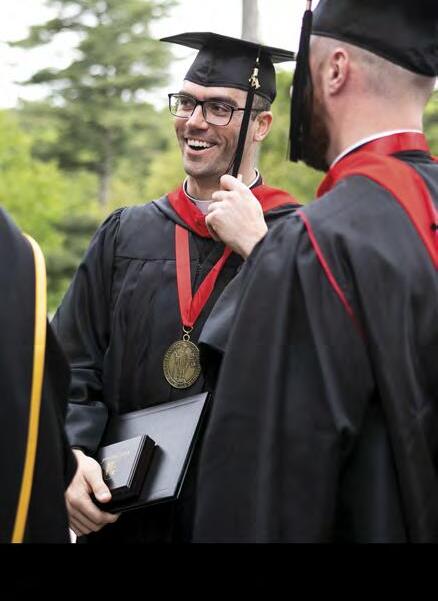
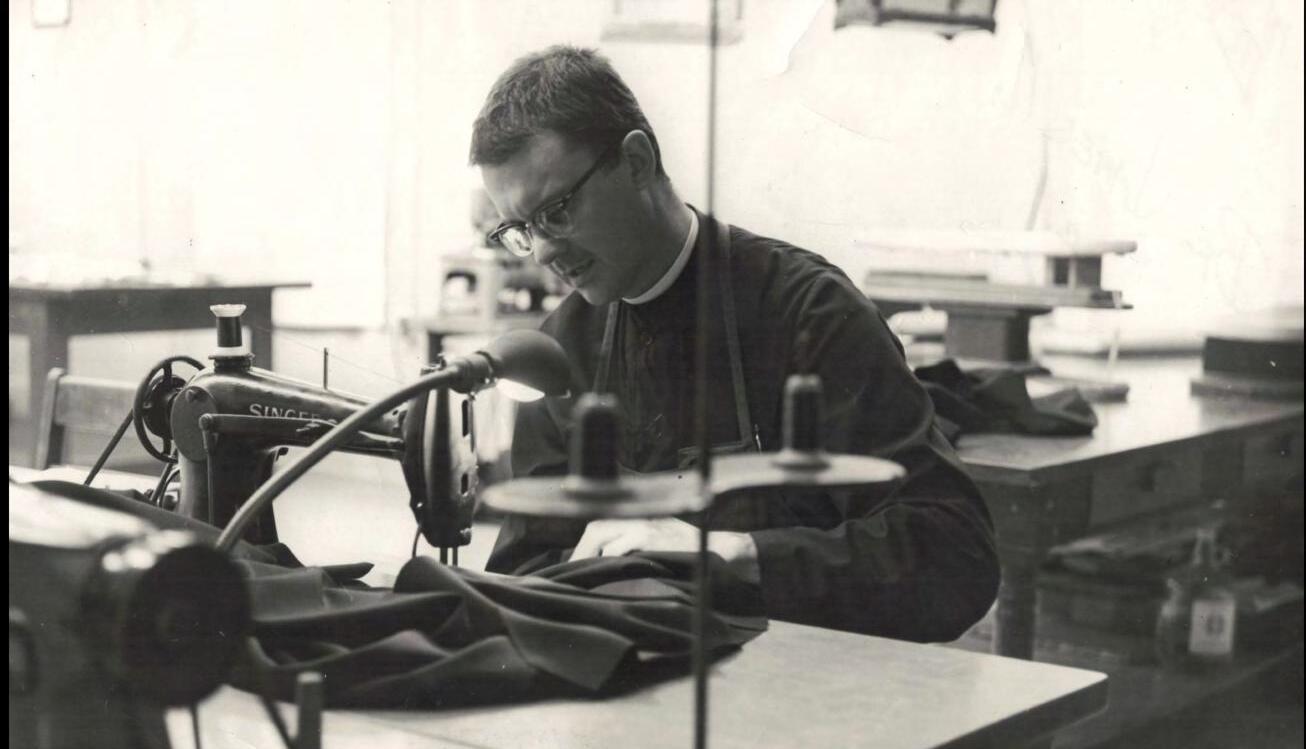

Until recently, the Shoe and Tailor Shop was housed in one of the oldest buildings on the Hill. The Tailor Shop opened at the turn of the last century on the third floor of the old monastery, in an area that is now St. Anselm Hall. It then moved to the fourth floor of Newman Hall before being relocated to the Abbey Press building.
In 1970, the Tailor Shop moved on top of the Hill, near St. Bede Hall, taking over the old bakery. This summer, the shop relocated down the Hill to the former packing plant building.
Br. Angelo Vitale, OSB, was a main staple of the Tailor Shop. He worked there for over 55 years and managed it from 1973 until his death on May 2, 2021. He was a graduate of the Mayer School of Fashion Design in New York and a certified orthopedic technician from Ball State University.
Stepping into the Tailor Shop is like stepping back in time. Seamstress Marja Schatz spends her days surrounded by old
sewing machines, including a Singer from the 1940s and a Reece Corp. Iron Duke Buttonhole maker that is nearly 100 years old. Until recently, Br. Peter Holden, OSB, helped Marja in the shop two afternoons a week.
The Tailor Shop is responsible for making custom habits, the distinct clothing monks wear, for Saint Meinrad’s monastic community and for 30 other religious communities across the country. They make 30-36 new habits a year and Marja estimates she has made around 660 over her 28 years working in the shop. The shop also creates cucullas (the pleated habit worn by solemnly professed monks), albs, work habits, stoles and purificators (cloths used to wipe the chalice after Communion).
“The habit is a wider cultural symbol of our
religious life and radical faith in God,” explains Br. Peter. “When you see someone wearing a habit, there is no question what that person stands for. They are giving a clear, public witness to their faith.”
The Tailor Shop recycles, repairs and stores old habits. When a monk passes away, his habits are sent to the Tailor Shop for repair and reuse if they are in good condition. Marja keeps a detailed binder that shows what pieces of the habit each monk has,




when they received them and which monk it came from. For example, Br. Peter’s work habit belonged to Fr. Gavin Barnes, OSB, who passed away in 2017.
“Even though I never met him before his death, it is very meaningful to know he is remembered, in a way, by my continuing to wear that habit,” says Br. Peter. “Recycling the habits is a way of knowing that we will be giving new life to this clothing, and that we are sharing a bit of our lives with someone else in the community, either living or deceased.”
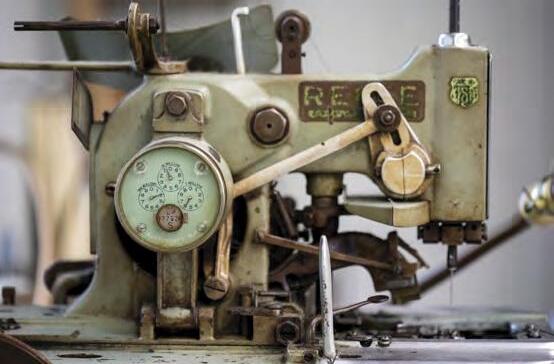
On average, the shop will go through 500 yards of black cloth and 280 yards of white cloth a year. It takes five to seven yards and 26 individual pieces of cloth to make a habit.
The Tailor Shop also repairs clothing and will take orders from anyone: faculty, coworkers, monks, students and people off the Hill.
“Hems, rips, tears, buttons, zippers, you name it, if someone brings it up here, we do it,” says Marja.
Br. Peter says the Tailor Shop remains important because it is one of the opportunities at Saint Meinrad for the monks to engage in manual labor.
“For as long as monks have existed in the West, manual labor has accompanied them,” explains Br. Peter. “It is something that is practical and helpful for the monastery. It reminds the monk of the difficulty of producing all of our worldly goods by teaching respect for the things around us, and it allows us to free our minds toward prayer.” W
The parts of the habit hold spiritual meanings to many of the monks who enter the monastery. The spiritual meanings have changed over time and vary from monk to monk.
The basic part of the habit is the tunic. The tunic covers the whole body
and represents the changing of self to become a new person in Christ. It is cinched by a basic black leather belt. The leather belt represents the discipline of celibacy and gives strength to the monk to persevere in solitary life.

Over the tunic, the monk wears a scapular. The scapular has a hood, also called a capuche, and fulllength cloth in the front and back. In ancient times, the scapular served as a work bib or apron to keep the tunic clean during manual labor. The scapular is symbolic of the yolk of Christ. The hood represents a helmet that protects the monk from the devil.
The cuculla is the voluminousouter garment worn by solemnly professed

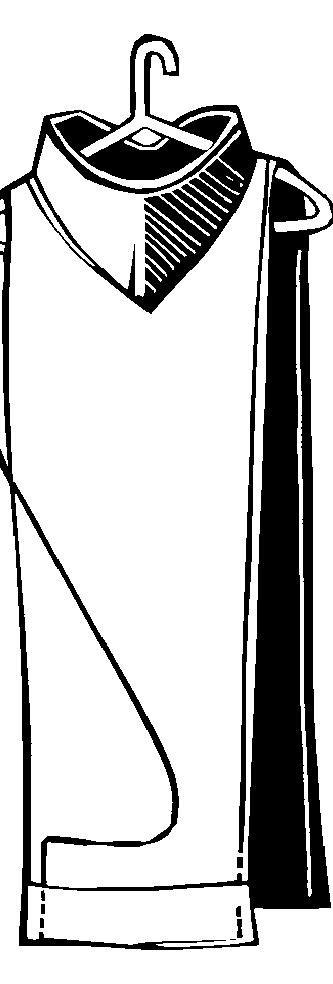
monks. This part of the habit signifies the monk’s death and burial as one who has renounced his old life to take up a new life in Christ. W
Following upon the liturgical reforms of the Second Vatican Council, when each nation’s vernacular language became the standard for use in the liturgy, Catholic liturgical musicians throughout the English-speaking world faced a number of shared challenges.
What were the best sources for good English hymns within the liturgy? Where would one find musical settings for the responsorial psalms and the other Mass parts? In addition to these needs, there was also the shared need for psalm tones –both in the Mass and in the Divine Office.
The psalm tones used with the Latin texts were written for psalm verses sung basically in couplets. They were also written with the accent patterns of the Latin language in mind. Following the Council, psalms began to be sung not only in one’s native language, but also in complete stanzas – sometimes three lines, four lines and up to as many as six lines.
In English-speaking Benedictine communities of men and women, where the liturgy plays such an important role in the daily life of the community, any number of monks and sisters took up the challenge and put their hand to the task of composing music for this “new” way of singing the psalms. In addition to crafting singable melodic patterns, these composers also needed to take into account the accent patterns of the English language.
It was in this context that the so-called Saint Meinrad Psalm Tones were born. In 1970, five years after the Council, work began on crafting psalm tones for each of the eight Gregorian modes. By the next year, the tones were complete and being used in our liturgies in the Church.
In the summer of 1973, at a meeting of Benedictine musicians, the Saint Meinrad Psalm Tones were introduced to the 120
Benedictine participants from all over the U.S., England, Canada, Central America and the Caribbean. Since everyone needed psalm tones – and because Saint Meinrad’s tones were found to be so versatile –they were very quickly adopted throughout the English-speaking Benedictine world.
From that modest beginning 50 years ago, the psalm tones have since made their way to many countries around the world. They are regularly used not only in Benedictine monasteries, but in parishes, religious communities and seminaries far and wide.


One little footnote about these psalm tones. While they are the work of three monks of Saint Meinrad – the late Fr. Columba Kelly, Fr. Samuel Weber and Fr. Tobias Colgan – one of the tones (Mode 8) was originally composed by a monk of Gethsemani Abbey in Kentucky, Fr. Chrysogonus Waddell.
Saint Meinrad “borrowed” his tone and adapted it a bit for our use. Years later, when approached about receiving due credit for his psalm tone, Fr. Chrysogonus waved off the idea, saying that his tone had now become known as one of the Saint Meinrad tones, and that he was fine with that!
If the liturgy in a Benedictine monastery is the heart of the community’s life, it is certainly true that psalm tones that can be sung effortlessly, from memory, help to keep the lifeblood of God’s Word flowing through the veins of the singers.
Saint Meinrad was blessed to be in a position 50 years ago to make this possible for countless numbers of the faithful from all walks of life. There is every reason to believe that this blessing will continue for many decades to come.
Note: You can find the Saint Meinrad Psalm Tones at www.saintmeinrad.org/ media/1478/meinrad_psalm_tones.pdf. W
October 20, 2021
Gary Alumni & Friends Dinner
November 10, 2021
Toledo Alumni & Friends Dinner
March 12, 2022 Day of Service
There is a tradition of holy men having ravens around them. In the story of St. Meinrad, a pair of ravens chased the robbers who killed the saint back into town and alerted the residents that something was wrong.
“St. Benedict also had ravens,” explains Fr. Harry Hagan, OSB. “When a wicked priest tried to poison the saint because he was so popular, St. Benedict threw the poisoned bread to the raven and told it to get rid of the poisoned bread, which it did.”
At Saint Meinrad, ravens can be found in the stained-glass windows in Memorial Lobby, and now they can be seen flying on a red flag alongside the American flag outside the Guest House.
The flag is similar to one Fr. Harry had seen in the town of Einsiedeln, Switzerland. He says it is tradition for every town in Switzerland to have their own flag. The coat of arms for the Abbey of Einsiedeln, Saint Meinrad’s motherhouse, is two black ravens on a gold field (gold, because it is an imperial abbey). The town of Einsiedeln has a coat of arms with two ravens on a red field.
In 2019, plans were being made to celebrate Saint Meinrad’s 150th anniversary of being raised to an abbey. A statue of St. Meinrad was proposed, and Fr. Harry suggested a replica of the town of Einsiedeln’s flag be created.
Br. Martin Erspamer, OSB, created the artwork of the two ravens, and the flag’s

color is the same shade of red that can be found all over campus.
Now the holy men of Saint Meinrad Archabbey have ravens flying high above campus, looking over them. W






Starting top left, clockwise: Diocese of Owensboro Bishop William Medley congratulates newly ordained priest Fr. Corey Bruns at St. Stephen Cathedral in Owensboro on May 22.
Kathleen Hedler chats with Sr. Mary Teresa Burns before the start of class on May 15.
Ryan Winger pitches to Nonso Ohanaka during the seminary softball tournament on April 23.
Joseph Nam places his hands on the Book of Gospels with Archbishop Charles Thompson during the deacon ordination at Saint Meinrad on April 10.
Diocese of Owensboro Bishop William Medley gives the commencement address to graduates in St. Bede Theater on May 8.

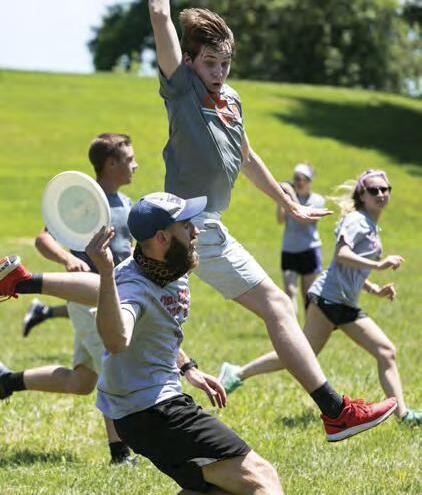



Starting top left, clockwise: Br. Kolbe Wolniakowski, OSB, places the funeral pall over the casket before the funeral Mass for Br. Angelo Vitale, OSB, on May 5.
“One Bread, One Cup” youth participant Zax Quirk tries to block the Frisbee being thrown by OBOC intern Joel Kelly during an Ultimate Frisbee game on June 17.
Fr. Simon Herrmann, OSB, blesses Archbishop Charles Thompson on the Archabbey Church steps after being ordained to the priesthood on June 27.
Fourth-year theology seminarians chat in the UnStable after a dinner of pizza and wings hosted by the Saint Meinrad Alumni Association on April 22. From left are Corey Bruns, Br. Jerome Aubert, OSB, Omar Galvan and Brian McCaffrey.
“One Bread, One Cup” youth participant Christina Knight and intern Clare Schomogyi line up outside St. Thomas Aquinas Chapel before the conference closing Mass on June 18. The girls were in the liturgical arts formation session and made candles for the Mass.
Sir Basil Hugh Albury, KHS, O’67 (’6165), of Nassau, Bahamas, died on April 1, 2021.
Mr. Edward Bowman O’58 (’46-53), of Indianapolis, IN, died on September 16, 2019.
Mr. Michael Brown C’99 (’93-98), of Summerville, SC, died on November 11, 2020.
Mr. Paul Campbell O’66 (’54-56), of Clarksville, IN, died on March 17, 2021.
Mr. Joseph Cramer O’61 (’50-51), of Bossier City, LA, died on August 25, 2009.
Mr. Charles “Kevin” Ehringer O’69 (’57-59), of Jeffersonville, IN, died on April 8, 2021.
Fr. Thomas Engbers O’67 (’55-57), a priest of the Archdiocese of Miami, FL, died on October 5, 2020.
Rev. Lee Ganim O’63 (’55-57), of Port St. Lucie, FL, died on June 5, 2020. He was a Maronite Catholic priest.
Mr. Patrick Gorman O’56 (’52-55), of Louisville, KY, died on February 11, 2021.
Fr. Richard Heymen O’56 (’50-56), a priest of the Diocese of Green Bay, WI, died on November 1, 2020.
Mr. Robert Ingraham O’77 (’69-71), of Wheaton, IL, died on February 22, 2021.
Mr. Michael Johnson T’99 (’93-95), of Richmond, IN, died on September 5, 2016.
Fr. Herman Lutz O’59 (’53-55), a priest of the Archdiocese of Indianapolis, IN, died on April 20, 2021.
Mr. James McDavitt O’61 (’49-53), of Indianapolis, IN, died on March 25, 2021.
Fr. Alan Phillip, CP, O’67 (’65-69), a member of the Passionists of the Holy Cross Province, died on March 4, 2021.
Mr. Carl Roemele O’60 (’52-54), of Fombell, PA, died on December 14, 2020.
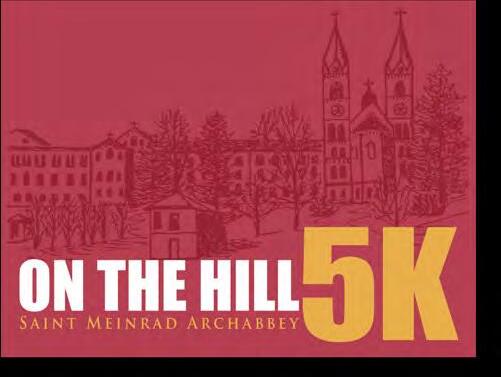
Mr. Gerald Sandoval O’82 (’78-82), of Ranchos de Taos, NM, died on March 27, 2021.
Mr. David Trautman O’73 (’61-66), of Pittsburgh, PA, died on January 31, 2021.
Fr. Robert Wilhelm O’59 (’53-55), a priest of the Diocese of Toledo, OH, died on March 11, 2021.
A key to the initials behind the names of alumni:
C: College
GTP: Graduate Theology Programs
HS: High School
MAT: Master of Arts (Theology)
MAPT: Master of Arts (Pastoral Theology)
MTS: Master in Theological Studies
O: Ordination
PD: Permanent Deacon Formation Program
S: Sabbaticant
SPH: St. Placid Hall
SS: Summer Session
T: Theology W

Mr. J. Griffin Crump, O’58 (’48-52), of Alexandria, VA, recently published a memoir, Good Fortune in Disguise, which is available from Amazon.
Dr. John Gillman, O’75 (’63-71), of San Diego, CA, has co-authored What Does the Bible Say About Angels and Demons? Published by New City Press, the book explores what Scripture says –and doesn’t say – about the reality of angels and demons.
Mr. Walter Glover, GTP’06 (’00-05), of Columbus, IN, has written his third book about his climbing adventures.
Mount Aconcagua and Mount Rainier Seven Mountain Story, Book III was published by Covenant Books. A portion of his book sales benefits children’s charities and nearly $150,000 has been raised so far.
Mr. Edward Huff, GTP’01 (’99-01), of Henderson, KY, recently opened a ministry/business in his community.
Henderson Helping Henderson provides active listening and referrals and promotes positive lifestyle alternatives. There is no charge for the confidential services.
Mr. Corey Koellner, GTP’20 (’13-20), of Louisville, KY, has been named the executive director of Right to Life of Louisville Inc.
Sr. Bernadine Lepak, SS’81 (77-81), will celebrate her 60th jubilee with the Sisters of St. Joseph of the Third Order of St. Francis this year. She lives in Garfield Heights, OH.
Mr. Bill Kopcsak, O’70 (’59-65), of Lakewood Ranch, FL, has written a book titled Ruth, More or Less. The book tells the true story of his aunt, who married a World War II panzer commander who was killed on the Russian Front and then married his uncle, a decorated tank commander under General Patton. The book is available on Amazon.
Fr. Bill Pruett, O’79 (’75-79), and Fr. Rick Stansberry, T’92 (’86-92), were presented with the 2020 Blessed Stanley Rother Faithful Shepherd Award on March 30. Both are priests of the Archdiocese of Oklahoma City. Fr. Bill is pastor of St. James the Greater Catholic
Church and Fr. Rick is pastor of Christ the King Catholic Church.
Fr. Mark Reyling, T’97 (’92-96), begins a new assignment on August 19 as the pastor of Our Lady of Mt. Carmel Parish in Herrin, IL, and Holy Spirit Parish in Carterville, IL.
Mr. John C. Schaffer, O’67 (’55-63), of Norwalk, OH, celebrated his 80th birthday on April 28.
Ms. Patricia Shevlin, SS’79 (’74-78), of Indian Head Park, IL, has written a book, My NUNcommon Life, about her 26 years as a member of the Daughters of Charity. The book answers the questions she gets asked most: Why did you become a nun? Why did you leave the community after so many years? What did you do next? The book is available on Amazon.
Dr. Bernard Verkamp, O’64 (’52-60), of Vincennes, IN, published “Karl Rahner and Religious Agnosticism” in Volume 32 of the Marquette University journal, Philosophy and Theology. W

Making gifts to support ministry opportunities, spiritual formation, and world-class theological education, alumni donors to Saint Meinrad continue to help prepare the future leaders of the Church.
As in years past, alumni showed their passion for supporting their alma mater with gifts totaling $937,434.91 during fiscal year 2020-21 – an impressive 25% response rate.
“As an alumnus of Saint Meinrad, I am proud to see the incredible generosity of our alumni,” says Tim Florian, director of alumni relations. “It is very encouraging to witness the love and ownership that our alumni have for Saint Meinrad and the formation opportunities for today’s students.”
Giving every year continues a long tradition of alumni supporting the formation of future ministers of the Church.
Alumni can give to Saint Meinrad online, by phone, or by mail in response to the kickoff of the 2021-2022 Annual Alumni Giving Program that will be mailed in late August.
Those who make a gift of $200 or more to the Alumni Annual Giving Program, or are first-time donors making a gift of $100 or more, will receive a 12-ounce wine tumbler. The vacuum-insulated, stainlesssteel tumbler is black, imprinted with the Saint Meinrad Alumni logo in white. W

200 Hill Drive St. Meinrad, IN 47577
Return Service Requested
Six members of the Saint Meinrad Alumni Board will be completing their terms this summer. Currently, two alumni are seeking seats on the Alumni Board. Other potential board members will be announced later.
Candidates are presented as a slate for approval. Alumni can submit their approval or disapproval by email to alumni@saintmeinrad.edu, by calling the Alumni Office at 800-682-0988 or by voting on the alumni website at http://alumni.saintmeinrad.edu. Voting ends July 30.
2007 - Present

Carolyn M. Berghuis, MTS’20, is an inspirational Catholic speaker, retreat leader, traditional naturopath, and author of Understanding the Jesus Code She has also created a Christ-centered forgiveness modality that helps individuals break free of emotional wounds called The LIVE Method.
Carolyn has spent over 20 years helping individuals experience real

transformation of body, heart and soul. Carolyn holds a bachelor’s degree in mathematics, a master’s degree in holistic nutrition, a doctoral degree in naturopathy, and a master’s in theology from Saint Meinrad Seminary and School of Theology. She did her thesis project for her theology degree on Julian of Norwich. Julian’s writings are the topic of many of Carolyn’s retreats.
Carolyn and her husband Scott have three children and eight grandchildren. They live in Carmel, IN, and their home parish is Our Lady of Mount Carmel.
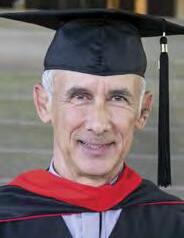
Mike Catalano, MA’21, is a deacon for the Diocese of Nashville, TN, and serves as a fulltime pastoral associate at St. Henry Catholic Church in Nashville. His previous work includes 24 years of various positions in the Tennessee Attorney General’s Office and 10 years as the clerk of the Tennessee Supreme Court until he retired in 2014.
He earned a bachelor’s degree in philosophy from Memphis State University and then graduated from the University of Tennessee College of Law in 1978. This year, he received a master’s degree in theology from Saint Meinrad Seminary and School of Theology.
Mike and his wife Janet have two college-age daughters and they live in Nashville, where they are parishioners at St. Henry Catholic Church.
The Office of the Alumni Association would like to thank the following board members for their six years of service: Fr. Jerry Byrd, Mr. Frederick Chandler, Deacon Richard Cooper, Fr. J. Randall Hubbard, Dr. Mary Diane Valentine, and Msgr. Christopher Vasko. W
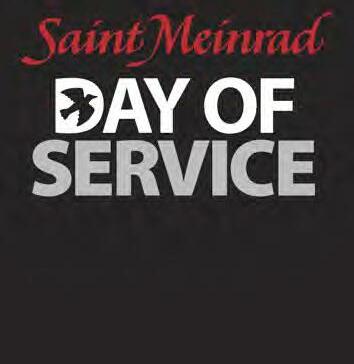
has been set for March 12, 2022